You can safely use handmade pottery in the microwave, but it's important to know what you're working with first. Most stoneware and porcelain pieces make excellent microwave-safe options, especially when they're made with lead-free glazes and fired at high temperatures. However, you'll want to avoid any pottery with metallic decorations or earthenware pieces that might be too porous. To test your handmade piece, place it in the microwave alongside a cup of water and heat for one minute – if it stays cool to the touch, you're good to go! There's plenty more to ponder when it comes to keeping your beautiful pottery safe and functional.
Understanding Microwave Safe Pottery
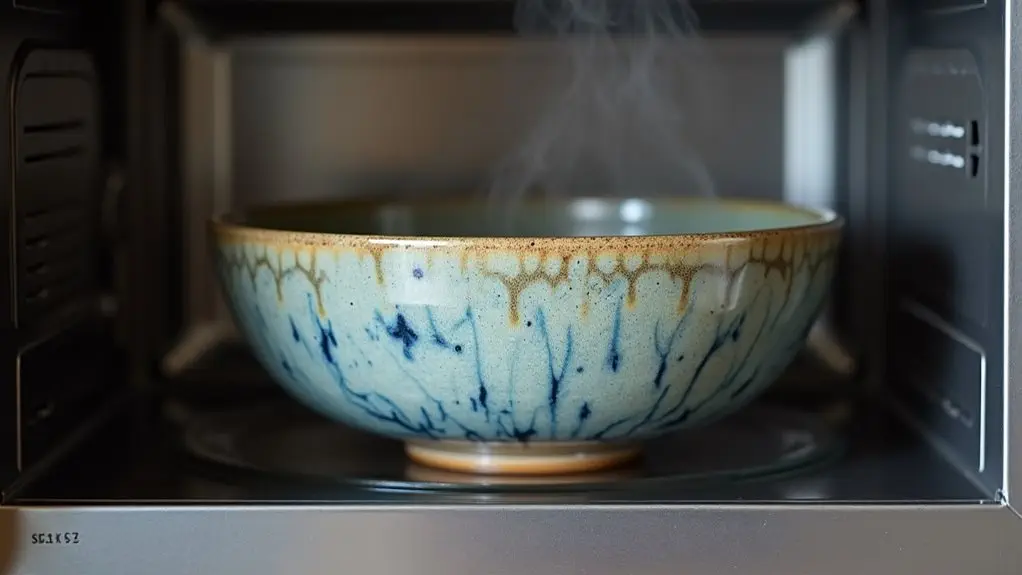
How can you tell if your handmade pottery is truly microwave-safe? When it comes to pottery durability, you'll want to look for pieces made from stoneware or porcelain, as they're your best bet for microwave safety. These materials are less porous and can handle those steamy microwave sessions like champs!
Your pottery's glaze matters just as much as its clay body. Make sure you're using pieces with lead-free, non-toxic glazes that fit snugly without any cracks. High-temperature firing during production helps ensure your pottery's durability in the microwave.
And here's a pro tip: check that your piece has even thickness throughout – those wonky, uneven spots can lead to hot spots and cracking (nobody wants their favorite mug doing a disappearing act in the microwave!).
Just remember to skip anything with metallic lusters, as they'll put on an unwanted light show in your microwave.
Testing Your Handmade Ceramics
Once you've identified potentially microwave-safe pottery, it's time to put it to the test.
Testing your handmade ceramics' durability isn't just about tossing them in the microwave and hoping for the best – there's actually a smart way to check their safety.
Remember to mark the bottom of any pottery that passes the safety test for future reference.
Here's your foolproof microwave testing method:
- Fill a microwave-safe cup with water (about ¾ full)
- Place both your pottery and the water cup in the microwave
- Heat on high for one minute while keeping watch
- Feel your pottery – if it's cool while the water's hot, you've got a winner!
Clay Types That Work Best
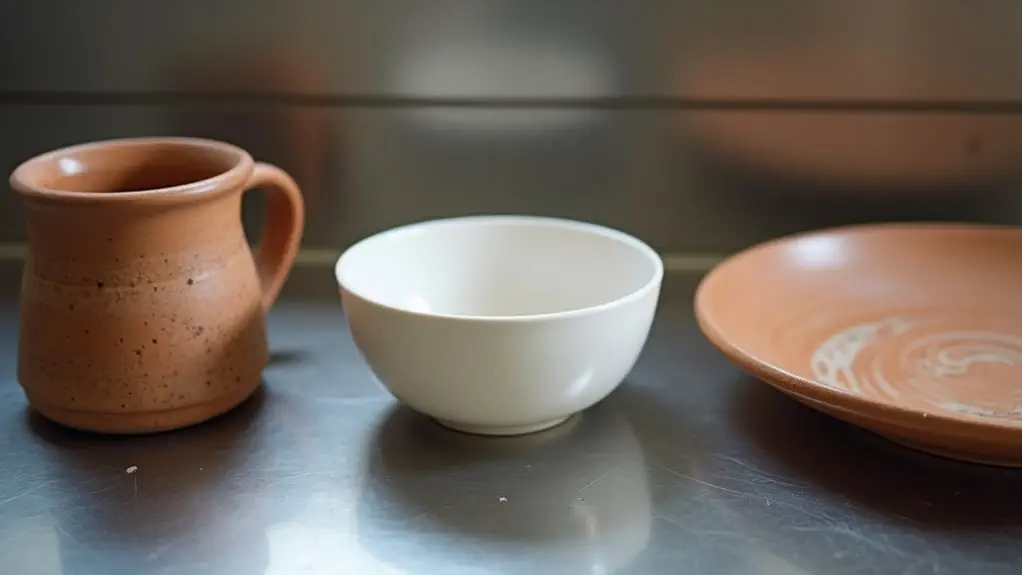
When choosing clay for microwave-safe pottery, you'll want to focus on stoneware and porcelain, which are fired at high temperatures and have exceptional heat resistance.
You're making a smart choice with these materials because they're non-porous and won't trap moisture that could lead to cracking or explosions in the microwave.
While earthenware might seem like a good option, it's best to skip it for microwave use since its porous nature and lower firing temperature can make it unstable when heated. You can visit Laguna.com to find high-quality clay options suitable for microwave-safe pottery making.
Stoneware and Porcelain Benefits
Stoneware and porcelain stand out as the two most microwave-friendly options for handmade pottery.
You'll love stoneware's durability, with its high-firing temperature making it incredibly resistant to chips and cracks. These pieces feature rustic, colorful glazes that make each one visually unique. The craftsmanship involved also highlights the appeal of handmade nature, adding character to every piece.
Porcelain strength comes from its dense, non-porous nature, allowing you to create delicate yet robust pieces that'll last for generations.
Here's why these materials are perfect for your microwave adventures:
- Both materials can withstand temperatures up to 450°F, making them ideal for reheating leftovers.
- They're non-porous, so they won't absorb food odors or release chemicals into your meals.
- Their excellent heat retention keeps your food warm longer.
- They're dishwasher-safe, making cleanup a breeze.
Just remember to avoid sudden temperature changes, and you'll enjoy these versatile ceramics for years to come.
Earthenware Safety Considerations
While stoneware and porcelain excel in microwave safety, earthenware presents several important challenges to contemplate.
When you're working with earthenware, you'll need to be extra cautious about thermal shock, as these pieces can crack or break when exposed to sudden temperature changes. Non-toxic materials make handmade ceramics generally safe for heating food and beverages. The porous nature of earthenware doesn't help its durability, making it less than ideal for microwave use.
If you're determined to use earthenware in the microwave, you'll want to focus on pieces made from white clay rather than black or red varieties.
Avoid any pottery with metallic decorations or lusters, as they can create dangerous sparking. You can test your piece's microwave safety by heating it briefly with water inside, but remember – never microwave empty pottery, and always let it warm up gradually to prevent damage.
Glazes and Safety Standards
When you're looking at handmade pottery for microwave use, you'll want to make sure the glaze is completely lead-free and has passed non-toxic testing standards.
You'll find that most modern glazes meet these requirements, but it's still important to check with your potter about the specific materials they've used. Stoneware and porcelain typically absorb minimal water, making them safer choices for microwave use.
Any metallic elements in the glaze, such as gold or silver lusters, are a big no-no for microwave use since they can cause sparking and damage both your pottery and your microwave.
Lead-Free Glaze Requirements
Since the safety of ceramic pottery directly impacts your health, understanding lead-free glaze requirements is crucial.
When you're choosing handmade pottery, you'll want to look for pieces with certified lead-free glaze formulation that meets FDA and EU standards. These modern glazes offer incredible advantages, including safety for food contact and peace of mind for your family's well-being. Modern regulations have evolved because even low levels of lead exposure can cause permanent IQ decline and other health issues.
Here's what you need to know about lead-free certification:
- Look for the AP (Non-Toxic) seal, which confirms the glaze meets safety standards
- Check for FDA compliance labels on commercially produced pieces
- Verify that glazes have been properly tested by approved laboratories
- Ascertain the pottery has undergone complete vitrification for food safety
Non-Toxic Testing Standards
To guarantee your handmade pottery is truly safe, you'll need to understand the established testing standards for non-toxic glazes. Leading organizations like The Art & Creative Materials Institute set strict guidelines that ensure your pottery won't leach harmful substances.
AMACO® products undergo continuous safety testing by professional toxicologists to maintain quality standards. When you're shopping for glazes, look for those AP (Approved Product) seal – it's your best friend in confirming non toxic materials have been used.
Independent laboratories conduct rigorous testing following ASTM standards to verify glaze safety. These tests check everything from material compatibility to leaching potential.
If you're serious about creating food-safe pottery, you'll want glazes with proper glaze certification that meets FDA requirements. It's like getting a safety stamp of approval that lets you create beautiful, functional pieces without worry.
Metallic Content Restrictions
Metallic glazes and decorations pose serious risks in the microwave, making them strictly off-limits for microwave-safe pottery.
When you're creating or using handmade ceramics, you'll need to be aware of metallic luster risks and chemical stability requirements to guarantee safety.
Pre-made glazes typically display food-safe symbols that indicate their safety status for microwave use.
Here's what you need to know about metallic content in your pottery:
- Gold, silver, and white gold decorations can cause dangerous sparking in your microwave.
- Even small amounts of metallic content in glazes can damage both your pottery and appliance.
- Your glazes must be completely metal-free to prevent arcing when microwaved.
- Chemical stability of your glazes is essential to prevent harmful leaching into food.
Always follow manufacturers' guidelines and remember – if you're unsure about your pottery's metallic content, it's better to play it safe and use another dish!
Metallic Decorations in Pottery
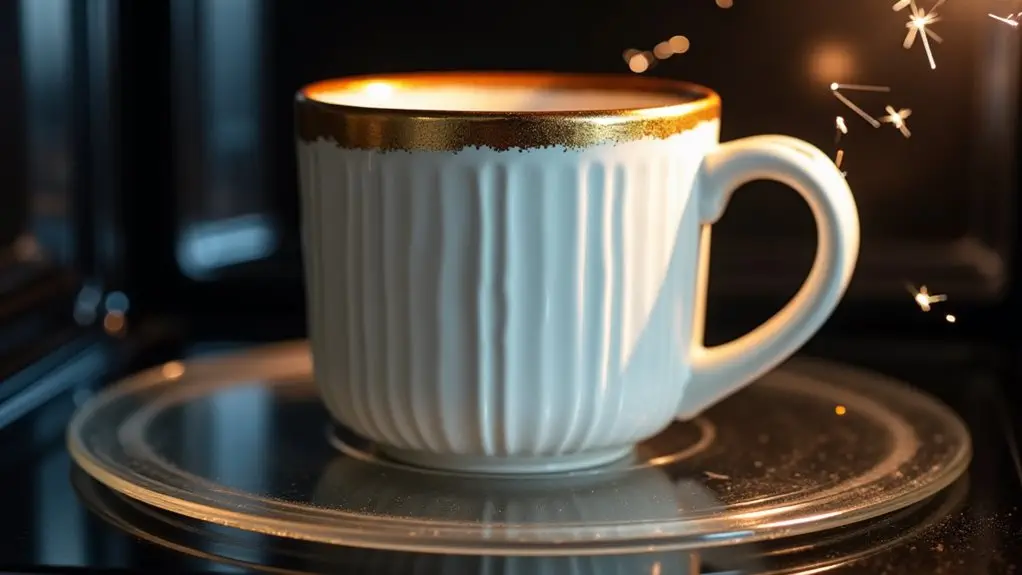
When it comes to microwaving handmade pottery, metallic decorations pose a significant safety risk that you can't ignore. Those beautiful gold-rimmed plates or pieces with metallic luster risks aren't worth the potential hazard they create in your microwave. Uneven heating can lead to serious burns and dangerous hot spots in your food.
Your decorative glaze safety should be a top priority, as metallic elements can cause dangerous sparking and uneven heating.
Want to play it safe? You'll need to test your handmade pieces before using them. Simply microwave the pottery alongside a glass of water – if your pottery gets hotter than the water, it's a no-go for microwave use.
Instead, opt for pieces made with non-metallic glazes and fully vitrified ceramics. Remember, those shimmering metallic accents might look stunning on your shelf, but they're best admired outside the microwave.
Temperature Changes and Pottery Care
Sudden temperature changes can spell disaster for your handmade pottery in the microwave. To prevent thermal shock and protect your favorite pieces, you'll want to handle temperature fluctuations with care.
Think of your pottery like a morning person – it needs time to wake up and wind down! This is especially important since pottery can expand up to 2% during heating due to natural quartz changes.
Here's how to keep your pottery safe from temperature-related damage:
- Never place cold pottery directly into a hot microwave – let it reach room temperature first.
- Start with shorter heating intervals to allow for gradual warming.
- Let your heated pottery cool naturally instead of rushing it.
- Skip the cold water rinse when cleaning heated pieces.
Signs of Unsafe Pottery
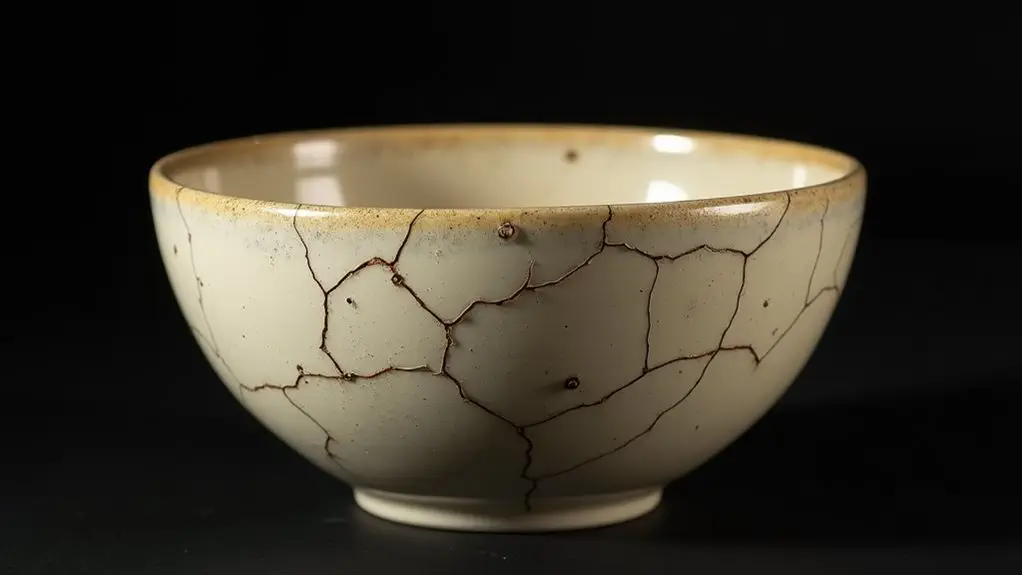
Looking to spot potentially dangerous pottery before using it in the microwave? You'll want to watch for several key warning signs that could spell trouble.
Start by examining the glaze for crazing indicators – those tiny hairline cracks that might look artistic but actually signal potential safety issues. These cracks aren't just cosmetic; they're perfect hiding spots for bacteria and can lead to serious leaching risks. Lead poisoning risks are particularly concerning with older glazed pottery pieces that may contain unsafe materials.
Keep an eye out for metallic finishes, especially those shiny gold or silver decorations that'll spark up your microwave like a disco ball (and not in a good way).
If you're working with older pieces or pottery from unknown sources, be extra cautious. Check for clear labeling, and when in doubt, perform a simple lemon test to check for chemical leaching before risking your favorite piece in the microwave.
Proper Usage Guidelines
Now that you can spot unsafe pottery, let's focus on how to use your handmade pieces safely in the microwave.
Here's how you'll get the most out of your beautiful ceramics while keeping them in pristine condition.
- Never microwave empty handmade pottery – always fill it at least halfway to distribute heat evenly.
- Start with short heating intervals and gradually increase time if needed.
- Let your pottery come to room temperature before microwaving to prevent thermal shock. Raku clay pieces are especially susceptible to cracking from sudden temperature changes.
- Allow heated pieces to cool naturally instead of rushing to rinse them.
Best Storage Practices
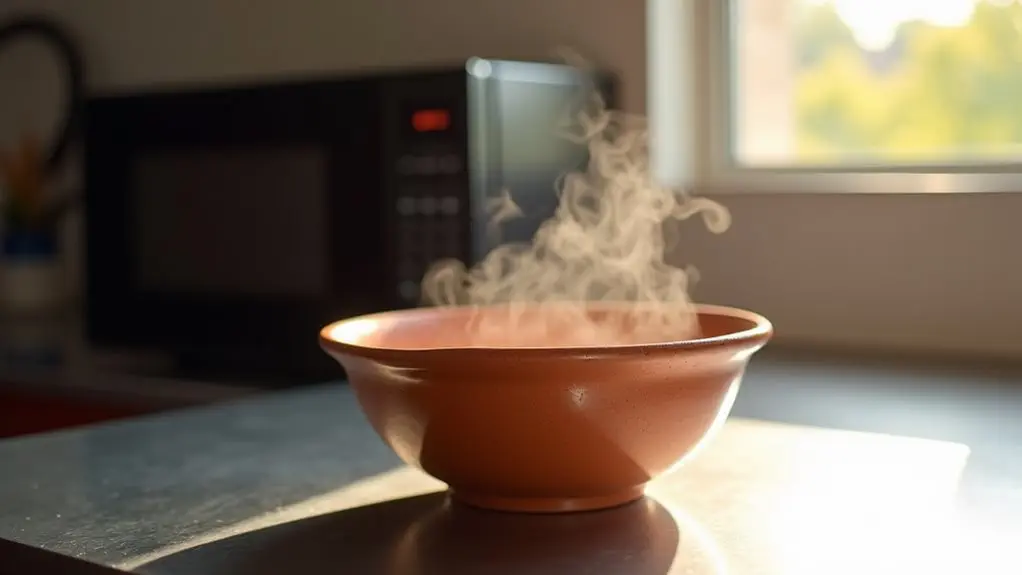
Proper storage makes all the difference in preserving your handmade pottery's beauty and functionality. When it comes to ceramic organization, you'll want to embrace smart storage solutions that protect your pieces from damage.
Don't stack those beautiful handmade mugs – instead, give them their own space to shine! You can use plate racks for your dishes, which prevents weight build-up and keeps everything easily accessible. Gentle hand washing is recommended over dishwasher use since movement can cause chips.
For items you're not using daily, wrap them carefully in tissue paper and store them in sturdy boxes with plenty of padding. Keep your pottery collection away from direct sunlight and heating vents, and always place heavier pieces on lower shelves.
Final Thoughts
Just like a trustworthy friend who's got your back, microwave-safe pottery will serve you well if you're mindful of its needs. You'll find that properly made ceramics can be your reliable kitchen companion, warming countless meals without a hitch. By understanding your pottery's composition and following safety guidelines, you'll protect both your handcrafted pieces and your peace of mind, letting you enjoy your favorite dishes with confidence.




